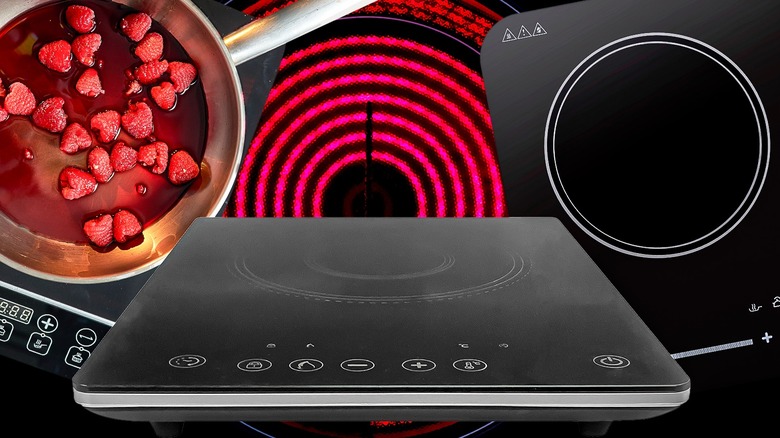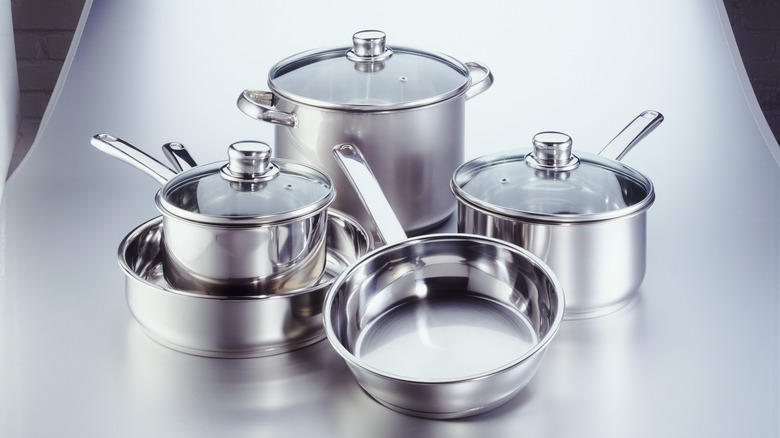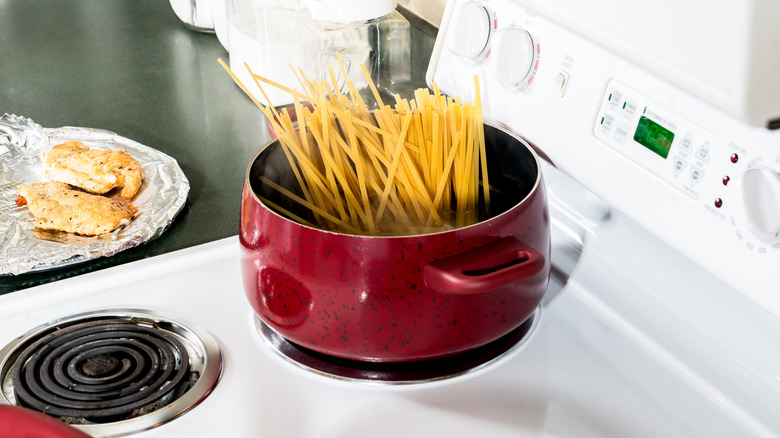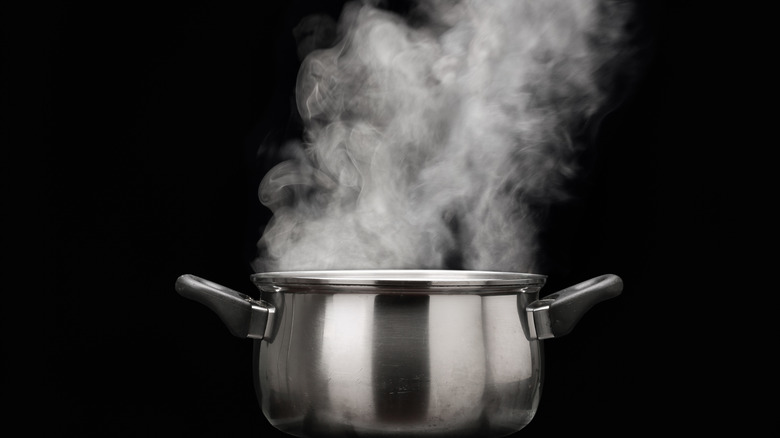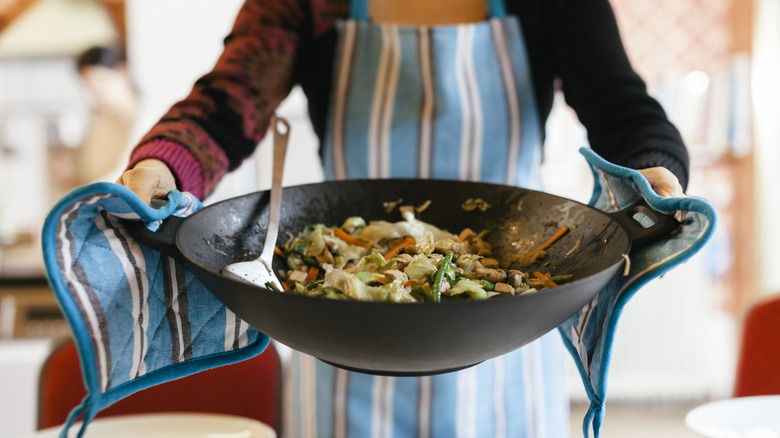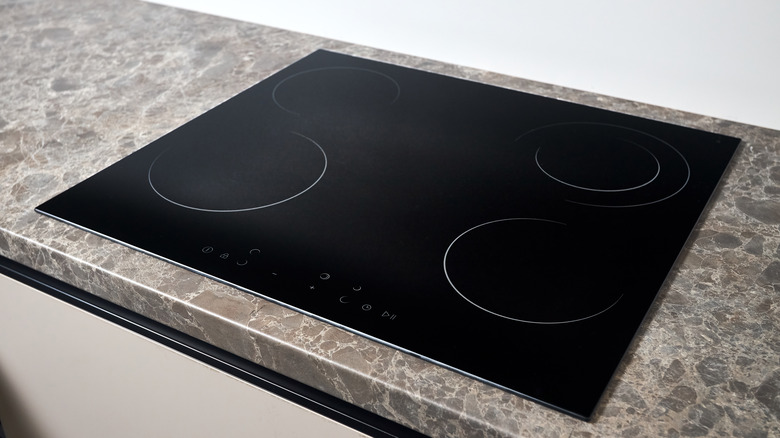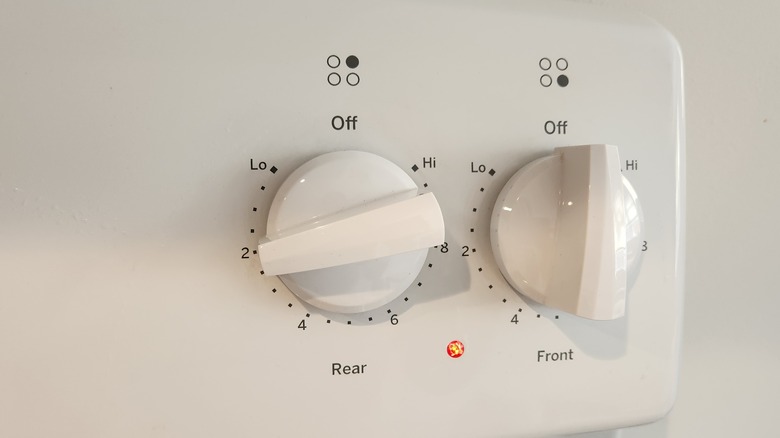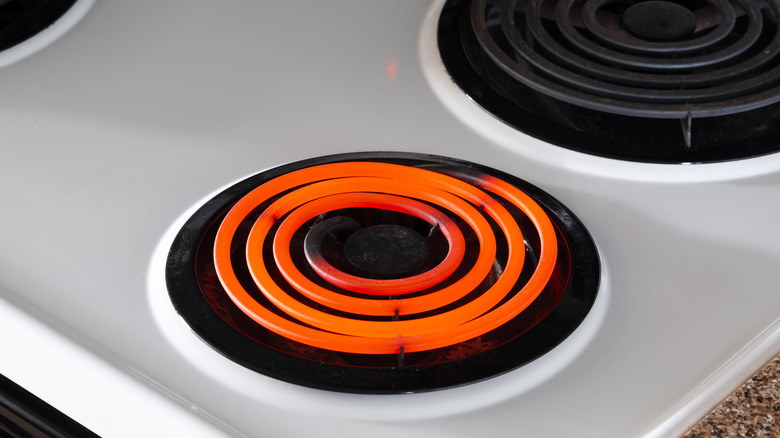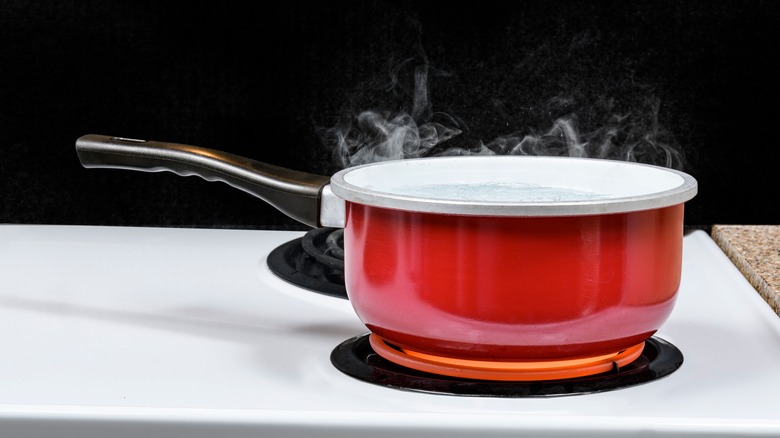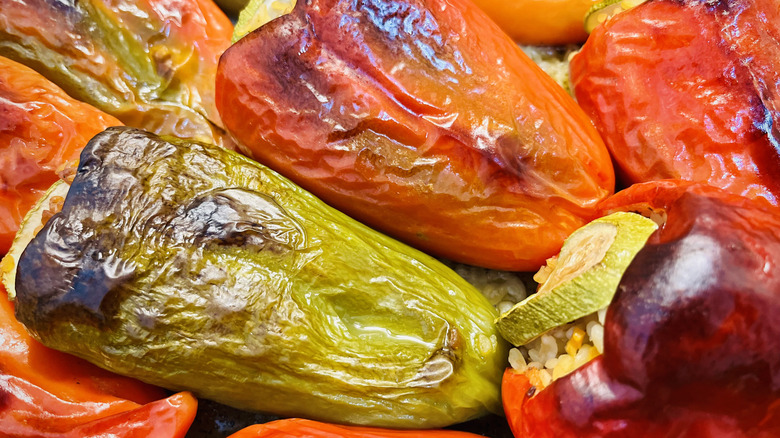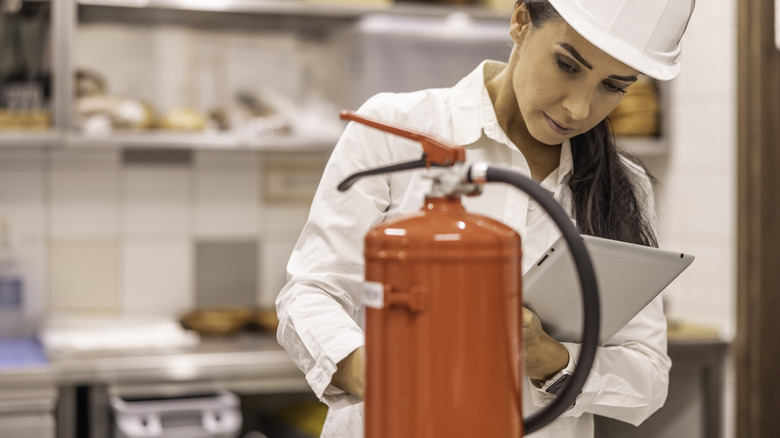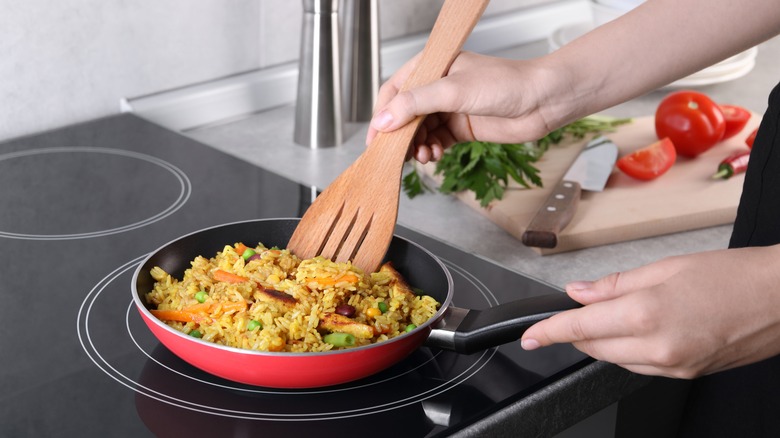11 Mistakes Everyone Makes When Cooking On An Electric Stovetop
We may receive a commission on purchases made from links.
Many consider gas stoves, especially in professional cooking environments, superior to electric ones because they produce faster temperature changes, are ideal for high-heat cooking, and have the visual benefit of an open flame. However, gas stoves have received negative press recently because of concerns that they contribute to unsafe indoor air quality. Electric stoves are presented as a healthier option in the home, and even some elite chefs have spoken out about their preference for electric cooking, although they are generally referring to using induction stoves. Some states are banning gas stoves in new construction, so we're likely to see more and more electric ranges in the years to come.
While there are pros and cons to both kinds of devices, electric stoves aren't a bad choice for the serious home cook. In fact, Consumer Reports lab tests show that electric stoves usually perform better than gas stoves. We reached out to Bree Lemmen, Whirlpool brand kitchen manager, for advice on avoiding common mistakes when cooking with electric stoves and for tips to maximize the potential of these popular household appliances. While switching from gas to electric may be a transition at first, with a little knowledge about how these stoves work, and by utilizing a few clever hacks, it's possible to cook all of your favorite dishes on an electric range, without worrying about toxic fumes in your home. Although induction stoves are a form of electric stove, we're focusing on traditional coil stoves in this article.
Not choosing the proper cookware
Most standard pots and pans are fine to use on traditional electric stoves, including stainless steel, aluminum, nonstick, cast iron (except with glass-topped stoves), and ceramic pans. Despite the abundance of choices, there are some considerations to keep in mind to achieve the best results.
First, choose heavy-bottomed pans when possible. While thin pans are able to respond quickly to temperature changes, whether that's heating up or cooling down, that's not always desirable. They're also more likely to warp in high heat. Thicker, heavier pans will hold onto heat for longer when you need it, and the bonus is they won't burn as easily. For an added boost, consider a copper-bottomed stainless steel pan. While beautiful, full copper cookware is expensive and hard to maintain. A copper bottom gives you the benefits of the metal's excellent conductivity, namely faster, more efficient, and even heating, without the price.
It's also best to choose a pan with a flat bottom to ensure the whole underside of the pan is in contact with the burner. Some cheap or lightweight pans may pitch to one side, usually from the weight of the handle, leaving the other side raised in the air. The food won't cook evenly and you'll have the annoying task of continuously rotating either the food or the pan. Besides the annoyance factor, an unbalanced pan will cause the heating element to continually activate and then turn off, wasting energy.
Using burners that don't match the size of your pots and pans
It's not just the material, but the size of your cookware that matters. "People should always try to use the cooking zone that best corresponds to the minimum diameter of the bottom of the pot," Bree Lemmen says. "This helps with even cooking and heating the pan efficiently. Mismatching burners and pot sizes could lead to longer heating and/or boil times, as well as uneven heat distribution throughout the cookware."
Using a pot that's too large for your burner can't always be avoided. Think hauling out your large stock pot to cook soup for a houseful of guests once a year on a holiday. You'll need to be patient with the longer heating times and stir frequently because the food on the outside edges of the pot won't get as hot.
It's more problematic to place a small pot on a large burner because the hot, uncovered coils are a burn risk, and the handles can become unsafe to touch. This electric stovetop mistake wastes a ton of energy, in fact, over 40% of the heat required to heat an eight-inch burner will be wasted if your pan's base is only six inches wide. Besides the environmental costs, this will hike up your electric bill. Some modern electric stoves offer a solution. "Electric ranges often feature dual/triple electric elements that have multiple rings; this helps achieve a proper fit for many kinds of pots and pans," Lemmen says.
Not having patience for slower temperature changes
You can get hotter food faster when cooking with a gas stove. "The burners on a gas cooktop give precise control over your flame level," Bree Lemmen says. "You can quickly adjust an open flame if a dish is cooking too fast or slow. For that reason, the burners heat up and cool down more quickly than an electric stove." However, she points out that "the burners on an electric stovetop often make for a steadier heat output with less temperature fluctuations."
If you've ever moved from a gas stove to an electric one, the first thing you may have noticed is that water takes longer to boil on a traditional electric stove, whether you're making a cup of tea or a pot of pasta, so keep this in mind when following recipes. You'll also need to give oil more time to heat up before you add ingredients to the pan.
Besides longer heating times, electric stoves also take longer to cool down. There is a space between the burner and the pan on a gas stove which allows for air circulation, so after the flame is turned off the pan cools down faster. But pans sit directly on electric burners. If you need to lower the temperature of cooking food dramatically, place it on an unused burner or use the two-burner method by heating a second burner to a lower heat and moving the pot there when you're ready.
Abandoning certain cooking techniques, such as stir-frying
According to Bree Lemmen, electric stoves can achieve the desired results of many cooking techniques, whether you're cooking your favorite stir-fry or reheating Chinese food for first-bite flavor. "Because they make direct contact with pots and pans, the cookware is actually more likely to retain heat," Lemmen says. "Additionally, electric stovetops often feature dual/triple electric elements that have multiple rings; this is a great bridging feature that's ideal for large or oddly shaped pots and pans such as a wok."
While gas flames do allow you to raise the temperature immediately, in terms of restaurant-quality dishes like fried rice, it doesn't matter if you have a gas or electric stove at home because a professional gas range in a restaurant will always get much hotter.
Just follow some creative workarounds to ace these dishes with an electric stove. Make things easier by buying a flat-bottomed wok the same size as your burner, and preheat the wok longer. Test it by throwing in a drop of water; if it sizzles immediately, it's ready. Cook stir-fry ingredients in small batches so the addition of unheated ingredients won't lower the temperature of the pan. Finally, modify the wok hei — the smoky and charred taste imparted by a hot wok — into a torch hei by passing a blowtorch over your food while stirring.
Not taking the right precautions with glass-topped electric stoves
Glass-topped electric stoves work the same way as coil electric stoves do. The difference is there is a smooth glass surface covering the entire stovetop, and pots are placed on the glass in the indicated burner positions. The glass creates an attractive appearance and makes it easier to wipe the stove clean without anything falling below the burners. Caution must be taken in order to keep the surface scratch- and damage-free, as the glass tops are more fragile than traditional stovetops.
Cookware choice is important. Most pots and pans are fine, but choose stainless steel if you can because they don't present any particular issues. Stay away from excessively large or heavy pots, like a full stockpot, which are heavy enough to crack the surface. "Owners of glass-topped electric stoves should be mindful to gently place pans on the surface to avoid damage and cracks and avoid sliding them around the stovetop," Bree Lemmen explains. "With the proper precautions to prevent damage, most types of cookware can be used on a glass-top stove."
Many people stay away from cast iron pans completely because the rough underside can scratch the surface. Avoid porcelain pans or those coated in enamel. With high enough temperatures, they can actually stick to the glass permanently. Cleaning tips for glass stovetops are equally as important as the choice of pots and pans. Choose non-abrasive cleaning products and sponges to prevent scratches.
Not learning how your stove performs
Gas stoves offer a good visual of the size of the flame, which cooks can watch as they adjust it up or down. In addition, the food in the pan reacts more quickly to the changes in temperature. Electric stoves normally have dials that control the temperature of each burner, the burner is covered by the pan, and the temperature changes are slower. The dials may be marked with the numbers one through ten, they may have the words high and low with numbers in between, or they may have another similar system. Stoves vary, especially when you change up the cookware, so take some time to get to know what these numbers mean for your stove's performance when you start cooking on an electric.
"The settings on electric stoves can vary and it's best to take time and care in getting to know your own settings," Bree Lemmen says. However, she offers the following recommendations for each general setting. Use the high setting for bringing liquids to a boil and cooking foods quickly. Medium-high is appropriate for maintaining a rapid boil or quickly browning or searing food. A medium setting can maintain a slow boil, fry or saute foods, and cool soups and sauces. Choose medium-low for stewing, steaming, or simmering food. The low setting will keep food warm or melt butter and chocolate. Finally, some stoves feature a warm zone, which is useful for keeping foods warm for later.
Underestimating how long it takes electric stoves to cool
With a gas stove, you can finish cooking, turn off the burner, and leave the pot in place. If you do that with an electric stove, you may find your food has overcooked or worse. This illustrates a fundamental difference between gas and electric stoves. Gas burners stop producing heat as soon as they're turned off, so it's fine to leave the pan where it is when you finish cooking. Electric coils need time to cool down. Once they're switched off, they remain hot enough to keep cooking food. You'll need to physically remove your pan from the burner to prevent this. Just move it to an unused burner or, if it's, say, Thanksgiving and all of the burners are occupied, move the pan to a hot plate on the counter or another available surface.
While the long cooling time is a problem if you burn your dinner, it's a plus if you want to keep the contents of a pot warm. This is not recommended for foods that are perfectly cooked, like seared meat, fish, or vegetables that would overcook or burn if left in place, but it can come in handy for dishes like soup.
A note of caution: when cooking on high, a burner will often turn red, but there's no visual way to tell a burner is hot when it's black. Don't touch the stove until you've given it enough time to cool, and take extra care with children.
Using the high setting indiscriminately
"The highest setting on your cooktop is ideal for rapidly increasing the temperature to fast boiling in the case of water, or rapidly heating cooking liquids," Bree Lemmen explains. While high heat is also used for searing meats and stir-frying, you don't generally need to choose the highest setting on an electric stove for that. In fact, using such a high heat makes it easy to burn your food.
Save the highest setting for bringing liquids to a boil. Cover the pot to raise the internal temperature and reduce the time the water takes to boil. This will also save energy. Once it's boiling, lower the heat. While the highest heat means a faster initial boiling time, the water's movements will be too vigorous for cooking. The water is likely to boil over, wetting the burner and causing a difficult cleanup job, especially if you're cooking something starchy like pasta that leaves a residue that's prone to burning. Get to know your stove. Lowering the heat to a medium-high setting can be enough to keep water at a rolling boil.
Choose your cookware wisely when cooking on high. Too high heat can damage and warp pans that aren't meant to be heated that high. Nonstick pans, for example, should never be heated beyond medium. If you happen to be using an older electric range, high heat can even cause blackening around the edges of the burner on the stove's surface.
Not discovering workarounds to char food
When you think of how to make perfectly roasted vegetables, using the oven often comes to mind. But sometimes you can use a gas stove for a similar effect. "The burners on a gas cooktop give precise control over your flame level and even allow you to char and grill foods directly using the burner," Bree Lemmen says. The advantage of a gas stove is that you can hold foods like peppers with tongs directly on the open flame, rotating them until all sides are charred.
That's not possible or safe with an electric burner. "We do not recommend placing any foods directly on an electric burner, as food can get stuck to the cooktop and create safety hazards. However, there are absolutely ways to achieve a variety of results with the help of cookware and creative cooking techniques," Lemmen explains.
A workaround is to use the oven's broiler or to char foods directly with a blowtorch. For a hack that's closer to roasting over an open flame, we recommend a chili roaster like this stainless steel round wire roaster from Amazon. This device features a metal grill with short legs that fits over an electric burner. It stands a short distance above the burner, so the foods placed on the rack benefit from being close to a strong heat source. It's an ideal tool for charring vegetables like chili peppers and bell peppers or roasting flatbreads like roti and tortillas.
Not learning about fire safety
Gas stoves have gotten press recently for air quality safety hazards, but electric stoves aren't risk-free. Possible dangers of electric stoves include fire and burns rather than air quality issues. If you're buying an electric stove, purchase the best quality unit that you can. Low-quality stoves, while cheaper, present a greater fire risk because they may have sub-par wiring or faulty components.
High-quality stoves are also more likely to have safety features like child locks, heat indicator warning lights, and automatic shutoff. Electric stoves stay hot even after the burners are turned off, and they take longer to cool down than their gas counterparts, so there's more time for something to go wrong. Sometimes people turn the wrong burner on by mistake or forget that the stove is on. Unattended electric burners heat up much higher than those with pots of cooking food on them, in which case the pot and food absorb some of the heat. Warning lights and automatic shut off help prevent fires or burns during these scenarios.
Always keep flammable items like kitchen towels away from the burners, as they can catch fire. Keep plastic items at a distance because they can melt and stick to the burner as well as emit toxic fumes. If that happens to you, try this baking soda hack can help you clean melted plastic from your stove. Finally, clean and inspect your stove for damage often, and know how to use your fire extinguisher before you need it.
Confusing the difference between electric and induction stovetops
Since they're both electric devices, some people may be confused about the difference between electric and induction stovetops. These two devices work differently and require different cookware. Bree Lemmen explains that the heat production method is the main difference between the two. According to Lemmen, electric cooktops "produce radiant heat by passing electricity between heating elements and sending heat waves to cookware," whereas induction cooktops "use copper coils to generate an electromagnetic field and heat cookware."
It's necessary to use magnetic cookware with an induction stove or the pot or pan won't heat up at all. "Induction cooktop technology turns pots and pans into their own heat source by creating electromagnetic energy through copper coils that directly interact with compatible cookware," Lemmen says. "As a result, induction cooktops can provide fast cooking and optimal temperature because the heat doesn't have to transfer through a surface."
For these induction cooktops, ferromagnetic cookware is recommended because they either contain a layer or are entirely made of magnetic materials. Lemmen says these include enameled steel, cast iron, or stainless steel designed for induction cooking. "When non-ferromagnetic cookware is used on an induction cooktop, it will not be detected by the burner and therefore will not heat," she says. Besides faster heating times and easier cleanup, induction stoves can be safer overall since the surface doesn't get hot. The pots and pans will still get hot, however, so appropriate precautions must still be taken.
